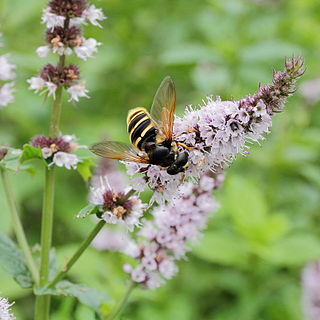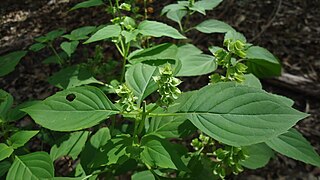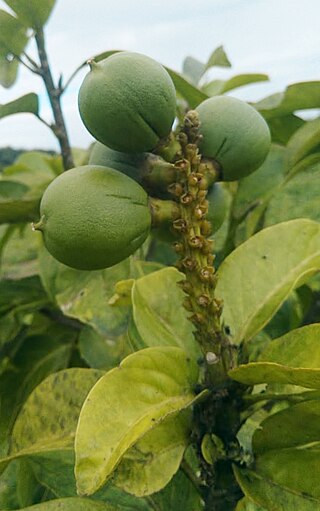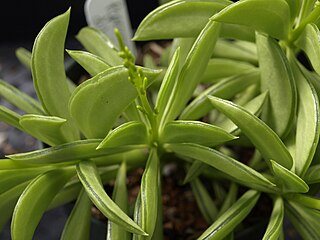
Mentha is a genus of plants in the family Lamiaceae. The exact distinction between species is unclear; it is estimated that 13 to 24 species exist. Hybridization occurs naturally where some species' ranges overlap. Many hybrids and cultivars are known.

Oregano is a species of flowering plant in the mint family Lamiaceae. It was native to the Mediterranean region, but widely naturalised elsewhere in the temperate Northern Hemisphere.

Piper, the pepper plants or pepper vines, is an economically and ecologically important genus in the family Piperaceae.

Spearmint, also known as garden mint, common mint, lamb mint and mackerel mint, is a species of mint, Mentha spicata (, native to Europe and southern temperate Asia, extending from Ireland in the west to southern China in the east. It is naturalized in many other temperate parts of the world, including northern and southern Africa, North America, and South America. It is used as a flavouring in food and herbal teas. The aromatic oil, called oil of spearmint, is also used as a flavoring and sometimes as a scent.

Tarragon, also known as estragon, is a species of perennial herb in the family Asteraceae. It is widespread in the wild across much of Eurasia and North America and is cultivated for culinary and medicinal purposes.

Peperomia is one of the two large genera of the family Piperaceae. It is estimated that there are at least over 1,000 species, occurring in all tropical and subtropical regions of the world. They are concentrated in South and Central America, but may also be found in southern North America, the Caribbean islands, Africa, Oceania, and southern and eastern parts of Asia. The exact number of species is difficult to determine, as some plants have been recorded several times with different names, and new species continue to be discovered. Peperomias have adapted to many different environments and their appearances vary greatly. Some are epiphytes or lithophytes, and many are xerophytes or possess underground tubers (geophytes). Most species are compact perennial shrubs or vines.

Anise, also called aniseed or rarely anix is a flowering plant in the family Apiaceae native to the eastern Mediterranean region and Southwest Asia.

Cortaderia is a genus of South American and Central American plants in the Poaceae grass family.

Bactris gasipaes is a species of palm native to the tropical forests of Central and South America. It is well spread in these regions, where it is often cultivated by smallholders in agroforestry systems or more rarely, in monoculture. Common names include peach palm in English, among others used in South American countries. It is a long-lived perennial plant that is productive for 50 to 75 years on average. Its population has an important genetic diversity, leading to numerous fruits, colors, and qualities. The fruits are edible and nutritious but need to be cooked for 30 minutes to five hours. They also benefit many animals in the wild. Peach-palms are also cultivated for the heart of palm, and the trunk can make valuable timber.

Weinmannia is a genus of trees and shrubs in the family Cunoniaceae. It contains 90 species, which range from Mexico through Central and South America including the Caribbean, and to the Mascarene Islands in the western Indian Ocean. It is absent from mainland Africa and Australia, but some fossils have been attributed to Weinmannia in Australia.

Piper aduncum, the spiked pepper, matico, hierba del soldado, achotlín, cordoncillo, higuillo or higuillo de hoja menuda, is a flowering plant in the family Piperaceae. Like many species in the family, the matico tree has a peppery odor. It grows wild on the coasts and in the forests of Central and South America and in the Interandean Valleys, up to 3,000 m (9,800 ft) above sea level.

Viguiera is a genus of flowering plants in the family Asteraceae. It contains around 19-40 species, which are commonly known as goldeneyes and are native to the New World. These are herbs to bushy shrubs that bear yellow or orange daisy-like flowers.

Iochroma arborescens is a species of flowering plant in the genus Iochroma, belonging to the nightshade family Solanaceae. Formerly it was considered the single species in the monotypic genus Acnistus. Common names include gallinero, mata-gallina, fruta-de-sabiá, hollowheart, wild tobacco, siyou, bastard sirio, galán arbóreo, tabaco de monte, nigüito, marieneira, güitite, and tabak djab.

Homolepis is a genus of Neotropical plants in the grass family. They are native to Mexico, Central and South America, and the West Indies.

Ocimum campechianum is a plant species in the family Lamiaceae, widespread across Mexico, Central America, South America, the West Indies, and Florida.

Caryodendron orinocense, commonly known as cacay, inchi or orinoconut, is an evergreen tree belonging to the family Euphorbiaceae.

Peperomia dolabriformis is a species of plant in the genus Peperomia in the family Piperaceae. The species is also known as prayer pepper. The plant is used as an ornamental houseplant. It is native to Ecuador and Peru.
Ottoa is a monotypic genus of flowering plants belonging to the family Apiaceae. It only contains one known species, Ottoa oenanthoides.
Peperomia macrorhiza is a species of plant in the genus Peperomia. It is endemic to Peru. It is a geophytic plant, storing water and reserves in an underground tuber. During dry periods parts above ground, such as leaves, will wither away but the plant will survive due to the tuber. When more rain falls the plant regrows its stalks and leaves on the surface.

Peperomia fraseri, commonly known as the flowering pepper, is a species of plant in the genus Peperomia of the family Piperaceae. Its native range covers Colombia and Peru. It has also been introduced to Ecuador and Guatemala.



















